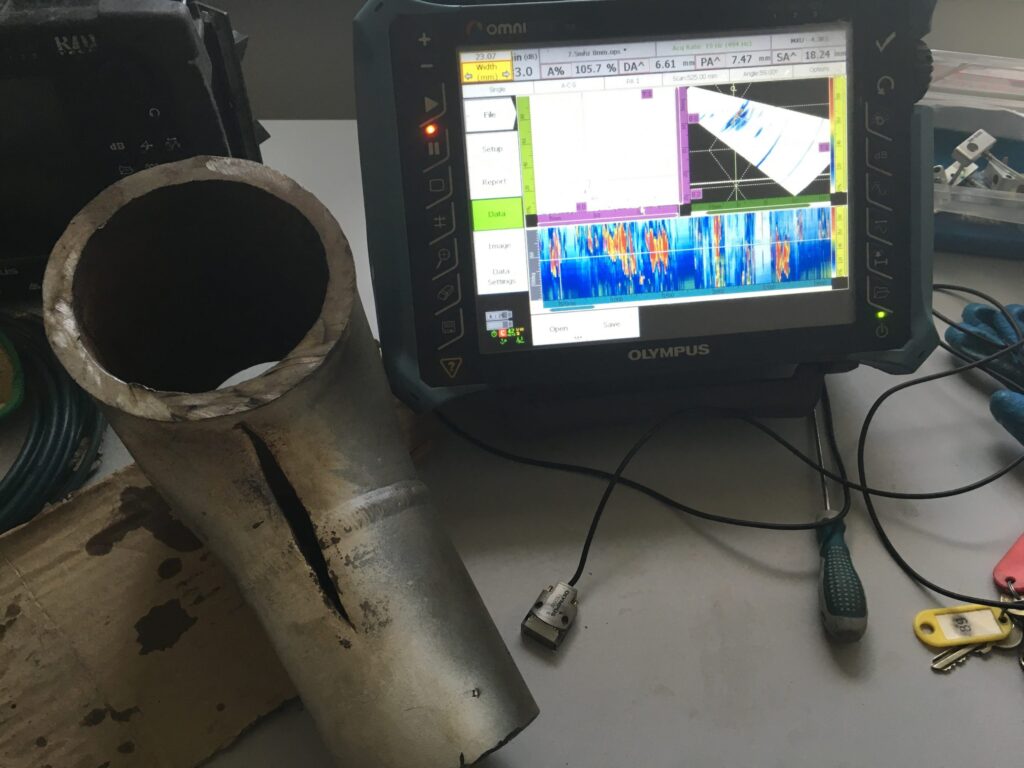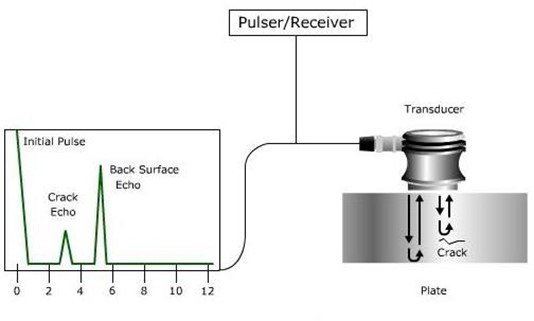NDT Codes And Standards: A Comprehensive Guide

Trying to understand NDT codes and standards can feel like a puzzle. These rules are key for safe and reliable construction projects. Our guide will make these complex topics easy to grasp.
Keep reading, it gets interesting!
Key Takeaways
- NDT codes, standards, and specifications guide how to test materials without damaging them. They help keep buildings, planes, and pipelines safe.
- ASNT is a global society that sets high standards for nondestructive testing professionals. It offers certification programs and resources.
- ASTM, ASME, API, AWS, AIA, the National Board of Boiler and Pressure Vessel Inspectors, ISO, CEN, and PED make important rules for different industries.
- To stay up-to-date with NDT practices: subscribe to newsletters from industry bodies like ASNT or ASTM; join forums; attend workshops; follow blogs; review accreditation websites regularly.
- Key NDT standards include the ASME Boiler and Pressure Vessel Code for pressure vessels’ safety worldwide and ASTM Standards guiding various testing methods.
Understanding NDT Codes, Standards, and Specifications
NDT codes, standards, and specifications act as the playbook for nondestructive testing. They lay down the rules and guidelines everyone must follow to ensure safety and quality in various industries.
From big construction projects to daily inspections of pressure vessels, these documents serve as a vital reference. Imagine them as a map that guides professionals on how to correctly perform NDT methods like ultrasonic testing (UT), magnetic particle testing (MT), and radiographic testing (RT).
Compliance with these regulations is not just important—it’s crucial. Think of it this way: following them makes sure buildings stand strong, airplanes fly safely, and pipelines carry oil without leaks.
Each country or industry may have its own set of rules, but the goal remains the same—to maintain high standards of safety and quality in everything we use daily.
The Role of ASNT in NDT Codes and Standards
ASNT stands tall in the world of nondestructive testing. It’s not just any society. Think of it as a big family, a global one with over 14,000 members who are all about making sure things like planes, bridges, and factories are safe without breaking them apart.
They’ve set the bar high for what it means to be an NDT pro. This is thanks to their tough standards and practices that decide who gets to call themselves certified NDT personnel.
They’re also behind some hefty guides and resources that help these professionals stay sharp. Imagine having a toolbox where each tool is designed just right for the job you need to do.
That’s what ASNT provides but for knowledge in NDT. Their certification programs aren’t just fancy pieces of paper; they’re passports into a world where every inspection or test could mean keeping people safe.
You might say ASNT plays detective in the realm of codes and standards—always updating, always clarifying. Through its exhaustive guides, it sheds light on complicated topics, making them easier for everyone in the field to understand and follow.
Also, let’s not forget those crucial qualifications and certifications needed worldwide by industries and governments alike; ASNT sets these rigorous benchmarks ensuring that only those truly skilled can carry out this important work.
Industry Standards Bodies and Their Relevance to NDT
Industry standards bodies play a key role in shaping NDT practices by setting the ground rules everyone follows, making sure everything checks out for safety and reliability.. So, let’s keep reading to see how they influence the world of non-destructive testing.
American Society for Testing and Materials (ASTM)
The American Society for Testing and Materials, or ASTM, is a big deal in the world of non-destructive testing (NDT). They’re all about sharing technical info and teaching materials that help make NDT work better.
Think of them as a huge library where people agree on what counts as doing things right. Their standards are like rules everyone agrees to follow, making sure everything is tested the same way.
ASTM’s role is pretty key because it makes sure that when you’re looking at something critical – be it a bridge, an airplane wing, or a pipeline – the methods used to check if they’re okay are top-notch.
Since these guys get together and decide on these standards through talking and agreeing, it means no one’s left guessing how to do their job properly in NDT. Plus, it helps everyone understand each other better when they’re talking about safety and quality across borders.
American Society of Mechanical Engineers (ASME)
ASME stands tall in the world of mechanical engineering, crafting standards that shape how industries work. It’s all about setting the bar high – from pressure technology to nuclear components, ASME guides ensure safety and efficiency.
With a strong focus on nondestructive testing (NDT), these standards help experts find flaws without causing harm.
In the realm of NDT, ASME’s role cannot be overstated. Their certifications and guidelines are vital tools for professionals making sure that everything from boilers to bridges stays in top shape.
This is crucial for public safety and keeping businesses running smoothly. Plus, being part of global discussions on industrial practices places ASME at the heart of innovation and progress in engineering fields.
American Petroleum Institute (API)
The American Petroleum Institute, also known as API, plays a huge part in the world of oil and natural gas. Since 1924, it’s been making standards to help this industry work better and safer.
Think of API as a big team leader. It brings together smart people who know loads about oil and gas. They chat, think, and decide on the best ways to do things. This way, everyone can follow rules that make sense and keep things running smoothly.
API looks after nearly 800 standards covering everything from how to find gas underground to how we get it into our homes safely. These guidelines are super important for nondestructive testing or NDT in short.
Why? Because they help make sure everything is checked without breaking it apart. Imagine checking a huge pipeline for safety without causing any damage! That’s what these standards help do – making sure workers and our environment stay safe while getting the job done right.
American Welding Society (AWS)
AWS stands for the American Welding Society. This group started in 1919 and focuses on making welding better and safer. They make rules and guidelines that help people do their welding jobs right.
With more than 350 standards, AWS covers a lot of ground, including the D1.1 Structural standards which are very important.
This society also helps people learn with an online course on Non-Destructive Testing (NDT). NDT is all about checking materials without damaging them. It’s crucial for making sure things are safe and strong enough without breaking them apart.
AWS plays a big part in setting these NDT standards too, helping ensure everything from bridges to buildings is put together properly.
Professionals can find lots of resources through AWS, especially when it comes to codes and standards related to welding and non-destructive testing. Whether you’re looking into the science behind welding or need guidelines for your next project, AWS has something useful.
Since its start as a nonprofit organisation, its main goal has been to push forward the technology and know-how around welding processes.
Aerospace Industries Association (AIA)
Moving from the focus on welding standards with AWS, we delve into the aerospace domain with AIA. The Aerospace Industries Association champions innovation in aerospace through policy advocacy and investment.
With over 1,400 active standards at their disposal, they lead in setting benchmarks for quality and safety in aerospace manufacturing and maintenance.
AIA not only manages national publications but also shapes American National Standards specific to this high-flying industry. Recognised by the American National Standards Institute, it plays a crucial role in ensuring that NDT methods meet the stringent demands of aerospace applications.
Through resources like “Facts and Figures,” AIA provides insights essential for keeping up with industry trends and requirements.
National Board of Boiler and Pressure Vessel Inspectors
After exploring the world of aerospace standards with AIA, we pivot to a critical player in ensuring safety across industries involving high-pressure systems. The National Board of Boiler and Pressure Vessel Inspectors stands as a guardian of compliance, extending its reach beyond borders.
This body works tirelessly to ensure that laws, rules, and regulations around boilers and pressure vessels are strictly followed.
Its members hail from nearly every corner of North America along with major industrial players globally. They play an essential role by linking industry standards bodies together for the development and publishing of key industrial codes regarding NDT methods.
Not only does this board offer crucial resources like the NB-380-1 Workbook and Inspection Log, but it also provides virtual seminars aimed at sharpening the skills of professionals in the field.
Through rigorous research and testing new designs in their lab, they’re shaping safer operational practices one inspection at a time.
International Organization for Standardization (ISO)
ISO stands for the International Organisation for Standardisation. It’s a group that works on making international standards. These standards help solve problems and boost new ideas.
They’re key in many areas, including Nondestructive Testing (NDT). For NDT, ISO standards are crucial because they guide how to qualify and certify professionals who do this important work.
Having these rules means everyone has a playbook to follow. This makes things fair and safe across countries. Certification bodies check if companies or people meet ISO standards. This helps in keeping quality high everywhere.
Experts from all over come together at ISO to make these international rules, even for NDT. This effort ensures that the best practices are used worldwide, improving safety and innovation in industries like manufacturing and construction.
European Committee for Standardisation (CEN)
Moving on from the global scope of ISO, we find ourselves looking at CEN, an organisation that brings big changes to NDT in Europe. With 34 countries working together, CEN sets out standards that make things easier and safer across all of Europe.
This means instead of having different rules in each country, there’s one set for everyone—making life simpler for those who test and inspect without destroying.
CEN has been a major player since the sixties, focusing on how best to inspect building parts and machinery using NDT methods. They’ve made sure that people doing these inspections are well-qualified and know what they’re doing.
Also, because their standards replace dozens of national ones, equipment tested in one country will meet the expectations in another without extra hassle or cost. It’s like having a common language where none existed before—a big win for safety and efficiency across the continent.
European Pressure Equipment Directive (PED)
The European Pressure Equipment Directive (PED) deals with the design, make, and checks on pressure equipment. It covers items with a max pressure more than 0.5 bar. The PED sets strict rules to ensure safety in the making and use of these items.
It is key for those working in NDT to follow these rules closely.
Under PED, NDT workers must get approval from a recognised body for certain types of pressure gear. This makes sure they meet high standards in their work across Europe. Also, industry bodies tie into the PED by setting codes and standards that guide NDT methods used on pressure gear.
Next up, let’s look into “Standards Bodies from Other Nations”.
Standards Bodies from Other Nations
Countries around the world have their own groups that make rules for nondestructive testing (NDT). These organisations work hard to create standards, codes, and recommended practices.
Their goal is to make sure products are good quality, reliable, and the same no matter where they’re made. It’s like a global team effort—each country brings its best ideas to the table.
These international bodies help everyone speak the same language when it comes to NDT. They tackle tough questions about how to test things without breaking them and ensure safety across borders.
Thanks to them, a product tested in one country can be trusted in another. This teamwork makes International trade smoother and helps industries from different countries get along better.
Regulatory Agencies
Regulatory agencies play a key role in the world of NDT. They set the rules and make sure everyone follows them to keep things safe and reliable. Think of them as the referees in a game, ensuring fair play.
These agencies have the power to enforce standards and certifications across different industries. This means they check if companies are doing their testing right, using methods like UT, RT, or PT correctly.
They focus on public safety and quality control – important stuff when we’re talking about things like boilers, pipelines, or buildings that need to be strong and safe for people to use.
Agencies look at how tests are done and make sure workers are trained right. If something’s not up to scratch, they can step in. So basically, these bodies help guarantee that when an engineer says something’s good to go – it really is safe and built well according to global benchmarks like those set by ASME or ISO.
In this setup, organisations get guidance on best practices from ASTM International or the American Welding Society (AWS), but it’s the regulatory guys who ensure these guidelines turn into action on ground level – influencing everything from small workshops to big factories around the globe.
Their stamp of approval matters because it tells customers that products meet high international standards for quality management systems such as ISO 9001:2015.
Differences Between Codes, Standards, and Specifications
Codes tell us the rules we must follow, making sure things are safe and right. They’re like the laws in NDT (nondestructive testing) that say how to test things without breaking them.
It’s all about keeping everyone safe while checking stuff works as it should. Standards, on the other hand, are more like helpful hints. They guide us on doing NDT the best way possible, using methods that have worked well before.
This helps make sure everything is top quality and consistent no matter where you are or what you’re working on.
Specifications get really specific — they outline exactly what needs to be done or what features something must have. Think of it as a shopping list for materials or a recipe for a service; everything has to match up just right or it won’t work properly.
So, every time we use ultrasonic testing (UT), radiographic testing (RT), or any type of NDT method, specifications ensure we know exactly what’s needed down to the very last detail..
Now let’s dive into how these important codes and standards come into being.
How NDT Codes and Standards are Developed
Creating NDT codes and standards is a meticulous process, demanding cooperation from experts across the globe. It ensures safety, quality, and reliability in various industries. Here’s a glimpse into how it all happens:
- Identify the need – First off, industry professionals or regulatory bodies spot a gap or requirement for new standards. Maybe there’s a new technology in non-destructive testing (NDT) or an update needed to improve safety.
- Form a committee – Next, a group of experts from different fields comes together. These folks could be engineers, scientists, or technicians with heaps of experience in NDT.
- Research and draft – The committee dives into research. They look at current practices, technical advancements, and gather data. Then, they start drafting the new code or standard.
- Review – Once the draft is ready, it’s not just pushed out. No, it goes through thorough reviews by other experts in the field. This step may go back and forth a few times to get everything just right.
- Public input – Here’s where wider feedback comes into play. The draft is shared with the public, allowing anyone interested to weigh in. It’s all about ensuring the standard is practical and covers all bases.
- Finalise and publish – After incorporating feedback, the standard gets one last review before being finalised. Then it gets published by bodies like ASTM or ASNT for everyone to use.
- Update regularly – Technology and methods keep changing; so do codes and standards! Regular reviews are done to update them as needed to stay relevant.
How to Stay Up-to-Date with NDT Codes and Standards
Staying current with NDT codes and standards is crucial for quality and safety. It ensures you meet the required standards and achieve accurate test results. Here’s how:
- Subscribe to newsletters from leading industry bodies, such as ASNT, ASTM, or ISO. These provide updates on new standards, revisions, and industry news.
- Join professional forums and online communities focused on non – destructive testing. Here, experts share insights, updates, and discuss changes in standards.
- Attend workshops, seminars, and conferences hosted by ASNT or similar organisations. These events are great for learning about latest practices and networking with other professionals.
- Enrol in training courses offered by accredited institutions. These courses often cover the latest NDT methods and changes in codes and standards.
- Follow blogs and articles published by experts in NDT. Writers usually explore recent trends, offering an easy way to keep your knowledge fresh.
- Utilise social media platforms like LinkedIn to connect with industry leaders. Many share valuable updates on NDT codes and standards on their profiles.
- Review websites of accreditation bodies regularly. They list down new certifications necessary for practitioners in the field of non-destructive testing.
- Purchase the latest editions of essential code books such as ASME BPVC or AWS Codes. Ensure your library is up-to-date for reference purposes.
Common NDT Codes and Standards Used in Industries
In industries, there’s a wide array of NDT codes and standards everyone follows to ensure things are up to mark—dive in to discover the essentials.
ASME Boiler and Pressure Vessel Code
The ASME Boiler and Pressure Vessel Code has been keeping people safe since 1911. It sets rules for making, checking, and testing pressure vessels to make sure they are safe to use.
This code is known all over the world and companies everywhere follow it when they inspect equipment that’s in use.
NDT methods play a big role in this code, helping to check if pressure vessels are in good shape without damaging them. Manufacturers across the globe rely on these standards – they’re like a common language for quality and safety in making pressure vessels.
Next up, let’s explore how ASTM Standards contribute to NDT practices..
ASTM Standards for NDT
ASTM standards are a big deal in NDT. They offer guidelines for things like ultrasonic testing, magnetic particle testing, and radiographic examination. Take ASTM E1316-23, for example.
It’s all about the words we use in nondestructive testing. The folks at ASTM make these rules using input from lots of people to ensure everything is up to scratch.
These standards aren’t just for show – they help keep materials and structures safe across various industries. Whether it’s checking a pipeline or making sure a bridge can handle its load, ASTM standards guide the process every step of the way.
Plus, being an American National Standard means they’re recognised as top-notch by experts around the globe.
API Standards for NDT
API has been busy over the past 100 years, crafting more than 800 standards. These are like secret recipes to make sure everything from oil rigs to pipelines is safe and sound. They’re big on keeping things eco-friendly too.
So, when it comes to non-destructive testing (NDT), API’s guidelines are a go-to for making sure everything checks out without breaking anything apart.
In industries where safety can’t take a back seat, API standards ensure that NDT methods like ultrasonic testing (UT) and radiographic testing (RT) are top-notch. This means less worry about nasty surprises in constructions or machinery.
Plus, sticking to these standards helps folks navigate through the maze of regulations with ease, ensuring their projects tick all the right boxes for quality and reliability.
AWS Codes for Welding Inspection
AWS Codes are key in North America for checking how good welds are. Think of them as a rulebook that people who check welds use. These rules help make sure everything is strong and safe.
AWS puts together many guides about welding well and checking it properly. They have experts sit down, talk it out, and agree on what the rules should be. Then, the American National Standards Institute (ANSI) says yes to these rules.
These codes cover lots of ways to test welds without breaking them. This includes looking at them closely, using magnets, or special rays that can see through metal! It’s all about finding any tiny mistakes before they become big problems.
Plus, AWS keeps updating their codes so they stay top-notch for keeping buildings, bridges, and other things safe.
So if someone is inspecting a welded structure in North America – odds are they’re following AWS guidelines to do their job right.
Impact of NDT Codes and Standards on Industry
NDT codes and standards keep things safe and top-notch, making sure everything works as it should. They help everyone play by the same rules, keeping trade smooth across borders.
Ensuring Quality and Safety
NDT methods, like ultrasonic testing (UT) and magnetic particle testing (MT), help spot defects in welds. This keeps materials and parts safe across many industries. A quick check with these techniques can make sure things stay safe and work well on job sites.
Having strong NDT standards means we can trust the quality of all sorts of materials. It’s key for keeping industry standards high. Next up, let’s talk about how smooth processes get when we use these guidelines right.
Streamlining Processes
Keeping industries safe and quality-controlled is crucial, but it’s also important to make things run smoothly. NDT codes and standards help in doing just that. They create a common language for everyone involved – from engineers to inspectors.
This means less confusion and faster decision-making.
With clear guidelines, companies can carry out inspections quickly and effectively. Workers know exactly what to do and how to do it. This cuts down on time wasted figuring things out or fixing mistakes.
So, operations become more efficient, saving time and money while keeping up with high standards.
International Trade and Compatibility
NDT codes and standards smooth out the bumps in international trade. They make sure that a product made in one country meets the safety and quality expectations of another country.
This compatibility is crucial for businesses looking to sell their products worldwide. It’s like speaking a common language where everyone understands what “good” looks like, thanks to harmonised standards such as ISO 9712.
These shared rules help in training and certifying NDT personnel too. With updates reflecting new industry needs, training programmes stay current, making skills globally relevant.
So, an engineer certified in European standards can work on projects around the world without hitches — breaking down borders within the engineering community.
For industries like aviation, governed by strict safety norms, this global understanding maintains high-quality levels across continents. Products are designed and tested under universally accepted practices; ensuring what flies or operates in one part of the world is safe everywhere else.
This not only boosts confidence among consumers but also opens up markets for manufacturers aiming for international success.
Conclusion
So, there you have it – a whistle-stop tour through the world of NDT codes and standards. We’ve looked at what they are, who makes them, and why they’re so important for keeping everything from bridges to boilers safe.
It’s clear that staying informed is key to making sure we’re all speaking the same safety language in industry. Remember, it’s not just about following rules – it’s about ensuring quality and safety every step of the way.
Keep curious, keep learning and let’s make things better together.
FAQs
1. What is NDT, and why do we use it?
NDT stands for non-destructive testing. It’s a way to check materials and structures without breaking them. We use it to make sure things like bridges, planes, and factory parts are safe.
2. Can you tell me about some types of NDT?
Sure! There are several types, including ultrasonic testing (UT), where sound waves find flaws in objects; magnetic particle testing (MT), which uses magnetic fields; radiographic testing (RT), similar to X-rays; and penetrant testing (PT), which finds cracks on surfaces.
3. What are NDT codes and standards?
They’re rules that help people do NDT the right way. These include guides from groups like ASME (American Society of Mechanical Engineers) and ISO (International Organisation for Standardization). They ensure tests are reliable everywhere.
4. Who makes sure NDT workers know what they’re doing?
There’s a system for this! Workers get qualifications and certifications based on standards like ISO/IEC 17024. This means they’ve been tested on their skills.
5. How does international cooperation come into play with NDT standards?
Groups like the International Accreditation Forum work across countries to agree on common ways of doing things. This helps companies trust each other’s work around the world.
6. Are these standards important outside industries too?
Yes, indeed! While they’re super important for making sure industrial stuff like refineries or power stations are safe, they also matter for everyday safety – ensuring everything from cars to playground equipment is good to go.





Responses